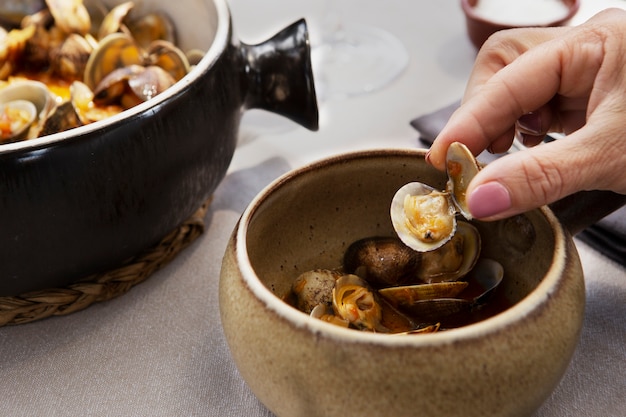Ever felt like your ramen routine needed a shake-up? You know, a little something extra to make it truly sing? That's where taro root comes in. This fascinating, slightly sweet, and wonderfully earthy root vegetable has the potential to transform your ramen into something truly special. And trust me, I've been down this road, and it's a delicious one!
Ramen has always been a comfort food for me, a reliable source of warmth and satisfaction. But, like any devoted foodie, I'm always on the lookout for new ways to explore its possibilities. It was on one of my usual trips to the local Asian grocery store that I spotted taro root for the first time. It was this gorgeous, almost purple hue, and I couldn't resist bringing it home. After a little research, I learned about its versatility and decided to give it a shot. The first time I added taro root to my ramen, it was like a culinary lightbulb went off! It brought a unique depth of flavour and a texture that was completely different from anything I'd experienced before.
So, if you're ready to embark on a ramen adventure with a twist, join me. We'll dive into the world of taro root, explore its unique qualities, and uncover delicious recipe ideas that'll have you saying "Wow, this is amazing!"
(Part 1) Taro Root: A Culinary Treasure

Introducing the Wonder That is Taro Root
Taro root, also known as eddo or dasheen, is a starchy root vegetable that's been a favourite in Asian and Pacific Island cuisines for centuries. It's not your typical root veggie, though. Its skin is a beautiful, almost purplish hue, and its flavour is a delightful mix of earthiness and subtle sweetness. The texture, too, is unique - a bit like a cross between potato and sweet potato, but with a more robust chew. It's also packed with fibre, vitamins, and minerals, so you're getting a healthy dose of goodness alongside the deliciousness.
Taro Root: A Culinary Chameleon
Taro root is incredibly versatile. It's a blank canvas for culinary creativity. You can boil, steam, fry, or roast it. It's amazing in soups, stews, curries, and even desserts. Some cultures even use it to make bread and crackers. So, you're not limited to just ramen, my friend. This root is a gateway to exploring a whole world of flavour possibilities!
(Part 2) Why Taro Root is a Ramen Rockstar

Elevating Your Ramen with Earthy Sweetness
Think of taro root as a symphony conductor for your ramen. It brings a sweet, earthy counterpoint to the salty, savoury broth, adding a complexity that just can't be achieved with other ingredients. The sweetness balances the richness of the broth, while the earthiness adds a deeper, more nuanced flavour profile.
Adding Texture that Makes a Difference
The texture is where taro root really shines. When cooked, it has a beautifully soft, almost melt-in-your-mouth texture that complements the noodles and other toppings. It also has a bit of chew, which creates a satisfying contrast and adds an interesting textural dimension.
A Touch of Asian Flair
Taro root is a staple in many Asian cuisines. Using it in your ramen brings a subtle but distinct Asian flavour profile, adding a touch of cultural authenticity and a hint of exoticism to your dish. It's a delicious way to explore different culinary traditions and flavour profiles.
(Part 3) Mastering Taro Root: Preparation and Cooking

Peeling the Taro Root
Alright, you've got your taro root. Now, let's get down to business. Peeling is the first step. Taro root skin can be a bit tough, so you'll need a sharp knife or a vegetable peeler. Be careful, though, because the sap can irritate your skin. It's a good idea to wear gloves. Once peeled, you can chop it into cubes, slices, or any shape you like.
Cooking Taro Root to Perfection
Here are the main ways to cook taro root, each with its own unique benefits:
- Boiling: The simplest method! Just toss the taro root into a pot of boiling water and cook until it's tender, usually around 15-20 minutes. A pinch of salt in the water adds extra flavour.
- Steaming: A fantastic way to preserve taro root's natural flavours and nutrients. Steam it for about 20-25 minutes, or until tender, in a steamer basket over boiling water.
- Roasting: For a touch of caramelization and a more robust flavour, roast the taro root. Preheat your oven to 400°F (200°C), toss the taro root with a little olive oil and salt, and roast for 25-30 minutes, or until it's tender and golden brown.
- Frying: For a crispy, golden brown exterior, fry your taro root. Heat some oil in a pan over medium heat and fry until cooked through and crispy.
Which method you choose depends on your personal preference and the recipe you're making.
(Part 4) Ramen Adventures: Taro Root Recipes
Now, let's get to the fun part! Here are two recipes that'll introduce you to the wonders of taro root ramen:
Recipe 1: Classic Shoyu Ramen with Taro Root
This recipe brings the classic ramen experience to a whole new level with the addition of taro root. It's a perfect balance of umami, sweetness, and earthiness.
Ingredients:
For the broth:
- 8 cups of chicken or vegetable broth
- 1/2 cup soy sauce
- 1/4 cup mirin (sweet rice wine)
- 1 tablespoon sugar
- 1 teaspoon ginger, minced
- 1 clove garlic, minced
- 1/2 teaspoon salt
For the ramen:
- 1 pound dried ramen noodles
- 1 cup cooked taro root, cubed
- 1/2 cup chopped green onions
- 1/4 cup nori seaweed, shredded
- 1 egg, soft-boiled
- 1 tablespoon sesame seeds
Instructions:
- In a saucepan, combine all broth ingredients and bring to a boil over medium heat. Reduce heat to low and simmer for 30 minutes.
- While the broth simmers, cook the ramen noodles according to the package instructions.
- To assemble, divide the noodles into bowls. Ladle the hot broth over the noodles. Top with the cooked taro root, green onions, nori seaweed, soft-boiled egg, and sesame seeds. Enjoy!
Recipe 2: Spicy Miso Ramen with Taro Root
This recipe is for those who like a little heat in their ramen. The miso broth, combined with the spicy kick, and the unique sweetness of the taro root creates a symphony of flavours.
Ingredients:
For the broth:
- 8 cups of vegetable broth
- 1/2 cup miso paste
- 1/4 cup soy sauce
- 1 tablespoon sesame oil
- 1 tablespoon chili paste
- 1 clove garlic, minced
- 1/2 teaspoon ginger, minced
- 1/4 teaspoon red pepper flakes (optional)
- 1/2 teaspoon salt
For the ramen:
- 1 pound dried ramen noodles
- 1 cup cooked taro root, cubed
- 1/4 cup sliced mushrooms
- 1/4 cup chopped green onions
- 1 tablespoon chopped cilantro
Instructions:
- Combine all broth ingredients in a saucepan and bring to a simmer over medium heat. Stir until the miso paste is fully dissolved. Reduce heat to low and simmer for 15 minutes.
- While the broth simmers, cook the ramen noodles according to the package instructions.
- To assemble, divide the noodles into bowls. Ladle the hot broth over the noodles. Top with the cooked taro root, mushrooms, green onions, and cilantro. Dive in!
(Part 5) Taro Root Ramen: A culinary adventure Awaits
Beyond the Recipe: Unleashing Your Inner Chef
These are just two starting points. The world of taro root ramen is your oyster! You can play around with different types of mushrooms, like shiitake or enoki. Experiment with different broths, like pork broth or even a vegetarian dashi. You can even add some spice with sriracha, gochujang, or a pinch of chili oil. Get creative and have fun!
Embracing the Unexpected: The Joy of Culinary Exploration
The beauty of cooking with taro root in ramen is in its ability to surprise you. It's a flavour and texture combination that might not immediately spring to mind, which makes it all the more exciting. It pushes you to try new things and discover new flavour profiles. And that's what I love about cooking - it's an ongoing adventure of experimentation, creativity, and discovery.
(Part 6) Tips for Taro Root Ramen Success
Here are some pointers to ensure your taro root ramen adventure is a delicious one:
Broth: The Foundation of a Great Ramen
- Start with a strong base: Whether you choose chicken or vegetable broth, make sure it's flavourful and has a good depth. You can even add umami by using kombu (kelp) or bonito flakes.
- Simmer it slow: The longer you simmer the broth, the more intense its flavour will become. Aim for at least 30 minutes, or even an hour for an ultra-rich broth.
- Seasoning is key: Taste the broth as it simmers and adjust the seasonings accordingly. You might need more salt, soy sauce, or sugar to achieve the perfect balance.
Taro Root: Getting It Right
- Cook until tender: Taro root should be soft and easily mashed when it's done. If it's still firm, cook it for a few more minutes.
- Don't overcook: Overcooked taro root becomes mushy and loses its wonderful texture. Aim for a soft, but still slightly firm texture.
- Consider size: Smaller pieces cook faster than larger ones. Adjust the cooking time accordingly.
Assembling Your Masterpiece
- Layer it up: Arrange the noodles, broth, taro root, and toppings in a way that looks as good as it tastes. You can create a layered effect by adding the noodles, broth, taro root, and toppings in that order.
- Freshness matters: Fresh toppings like green onions, cilantro, and nori seaweed add a burst of flavour and visual appeal. Experiment to find your favourite toppings.
- Add that final touch: A sprinkle of sesame seeds, a drizzle of chili oil, or a squeeze of lime juice can add a final layer of complexity and enhance the overall flavour profile.
(Part 7) Exploring Taro Root Beyond Ramen
Taro root's versatility extends far beyond ramen. Here are some other ways to enjoy this amazing root:
Taro Root Dumplings: A Taste of Tradition
For a truly authentic Asian culinary experience, try making taro root dumplings. They're a popular street food in many Asian countries and offer a delicious way to enjoy taro root's flavour and texture. Fill them with different things, like pork, shrimp, or vegetables. They make a fantastic addition to your ramen bowl or a delicious snack on their own.
Taro Root Fritters: Crispy and Delightful
Another way to enjoy taro root is in the form of crispy fritters. Simply grate the taro root, mix it with some flour, spices, and herbs, and fry until golden brown. Serve them as a side dish with your ramen or add them directly to the bowl for a satisfying crunch.
Taro Root Noodles: A Unique Ramen Twist
For a truly unique ramen experience, try making your own taro root noodles! It might sound complicated, but it's surprisingly easy. Grate the taro root and mix it with tapioca flour and water to create a dough. Roll out the dough and cut it into noodles. It's a fun, creative way to add a unique touch to your ramen.
(Part 8) The Journey Continues: A Love for Ramen, a Love for Exploration
My culinary journey has always been driven by a desire to discover new ingredients and flavours. Taro root, for me, was one of those ingredients that opened a whole new world of possibilities. It allowed me to explore different cuisines, flavours, and textures, and that's what keeps cooking exciting and fulfilling.
So, if you're looking to take your ramen game to the next level, give taro root a try. It's a delicious and exciting ingredient that can transform your ramen experience into something truly memorable. And who knows, it might even inspire you to explore other culinary adventures. The possibilities are endless!
FAQs
1. Is taro root good for you?
Yes! Taro root is a nutritional powerhouse. It's a good source of fibre, vitamin C, vitamin E, potassium, and manganese. It's also low in calories and fat. So, you can indulge in taro root guilt-free.
2. Can taro root be eaten raw?
While some people eat raw taro root, it's not recommended. Taro root contains calcium oxalate crystals, which can cause an itchy or burning sensation in your mouth. Cooking breaks down these crystals, making the taro root safe and delicious to eat.
3. How do I know if taro root is cooked?
Check the texture. Cooked taro root should be soft and easily mashed with a fork. If it's still firm, cook it for a few more minutes.
4. Can I use taro root in other dishes besides ramen?
Absolutely! Taro root is a versatile ingredient that works wonders in many dishes. It's amazing in soups, stews, curries, stir-fries, and even desserts. Get creative and explore its culinary potential!
5. Where can I find taro root?
Taro root is typically found in Asian grocery stores. You may also find it in larger supermarkets, especially in areas with a significant Asian population.
Everyone is watching

How to Cook Frozen Lobster Tails Perfectly: A Step-by-Step Guide
RecipesLobster. Just the word conjures up images of lavish meals, special occasions, and a taste of luxury. But let's...

Pigs in a Blanket Cooking Time: How Long to Bake for Perfect Results
RecipesAh, pigs in a blanket. Just the name conjures up images of those delightful little parcels of crispy pastry en...

Pork Fillet Cooking Time: How Long to Cook It Perfectly
RecipesPork fillet, or tenderloin as it's sometimes called, is a real favourite in our house. It's so versatile, and...

The Ultimate Guide to Tender, Juicy Pulled Pork
RecipesRight, let's talk pulled pork. It's one of those dishes that just screams "comfort food," doesn't it? I mean...

The Ultimate Guide to Cooking Delicious Frankfurters
RecipesLet's face it, we all love a good frankfurter. It's a classic, simple, and always satisfying. But let's be rea...
